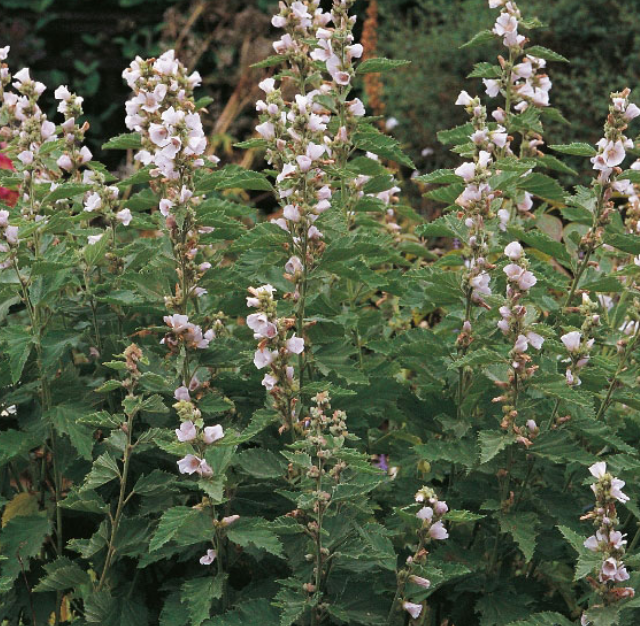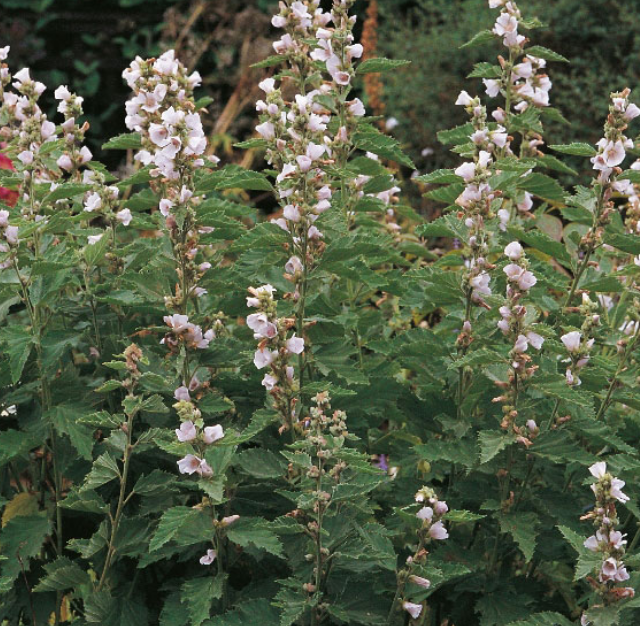Marsh Mallow
Marsh Mallow
Packet Size: 25 seeds
Couldn't load pickup availability
Marsh Mallow, Althaea officinalis, is a charming and useful plant with soft pink or white flowers that bloom in late summer through early autumn. This hardy perennial brings beauty to any garden and also supports wildlife — it’s an important food source for the caterpillars of the Painted Lady butterfly. Traditionally grown as a vegetable, the young leaves can be steamed and the flowers fried. Best of all, this is the original marshmallow plant — the one that inspired the classic treat! Each pack of seeds includes a simple recipe so you can try making your own marshmallow sweets at home.
SPRING & AUTUMN
- Sow seeds in pots or trays, no more than 5mm deep
- Cover the pots to retain moisture and place on a sunny windowsill or in a greenhouse
- Germination can be a bit erratic — be patient!
- Once seedlings have at least 2 true leaves, pot them on and keep moist while they establish a good root system
- Autumn sowings should be overwintered in a cold frame
- Established clumps can be lifted and divided
SUMMER:
- Give plants a liquid feed to keep them going strong
- Plant out later in the summer once they’re well rooted and the weather is right
📌USES
WILDLIFE FRIENDLY
- Flowers are a magnet for honey bees and bumblebees, offering abundant nectar and pollen through summer.
- Hoverflies visit regularly; their larvae help control aphids and other soft-bodied pests in your garden.
- Supports specialist moths like the Mallow Moth and the rarer Marsh Mallow Moth, which depends on marshmallow plants for its lifecycle—making it important for conservation in parts of the UK.
- Caterpillars of the Painted Lady butterfly feed on the leaves, adding to your garden’s butterfly diversity.
- The tall, soft foliage also provides shelter and habitat for a variety of beneficial insects and small wildlife.
- Leaving some seed heads over winter can help feed birds and provide habitat for overwintering insects.
EDIBLE
- You can make traditional Marsh Mallow sweets...recipe below!
- The flowers, root, and leaves of the marshmallow plant are edible
- Scatter seeds into salads or a few flowers on salads or puddings
- The leaves can be eaten raw or cooked – they will thicken soups and stews due to their mucilaginous content. Leaves and tops can be steamed and used as a veg.
- The root can also be eaten raw or cooked. Apparently they make a palatable dish when boiled and then fried with onions that is often used in times of shortage in the Syrian area – which leads one to think that palatable in this case means edible when there is little else!
- The water left over from cooking any part of the plant can be boiled until it has a similar consistency to egg white & then be used as an egg-white substitute in making meringues etc. by.
- A tea can be made from the flowers or from the root.
- The seeds (or ‘cheeses’ as they are known) can be eaten raw or toasted as a snack.
HISTORICAL
- Considered a delicacy in Roman times
- First formally recorded in 1548
- The species name officinalis complements the genus, indicating its use in mediaeval pharmacopoeias, later it features in Culpeper’s Herbal of 1653
- Marsh Mallow has a long history and has been used for medicinal purposes for centuries.
- The dried and powdered root was used to bind the active ingredients when making pills for medicinal use
- Considered magical, the root was often used in love and fertility spells.
- Marshmallow has also throughout history been used during departing rituals when someone has passed. It is thought that planting marshmallow near, or on the grave site, is an honour to those who have passed on.
OTHER
- The dried root can be used as a toothbrush
- A fibre from the stem and roots is used in paper-making and cordage.
- A glue can be made from the root by boiling it in water until a thick syrup is left in the pan, this syrup is used as a glue.
- An oil from the seed is used in making paints and varnishes.
- The medicinal properties of marshmallow root come from the mucilage, or sap-like substance, that the plant produces.
- Relieving coughs: the mucilage may have a soothing effect on the oesophagus by coating it.
- Protection from acid reflux: the mucilage can coat the oesophagus giving some protection from the stomach’s damaging acids
- Soothing skin irritation: may help with eczema & sun damaged skin (do not use it in place of proper sun protection), combine cooled marshmallow tea or mucilage extract with coconut oil
- Marsh Mallow root tea is best from dried root: pour on boiling water, cover and steep for 5 to 10 minutes then strain & drink adding honey for sweetness..
Caution: the mucilage may coat mouth, throat and into the stomach and may hinder the uptake of medicine taken orally - anybody wishing to use plants for medicinal effect are advised to consult their medical professional
Please Note: we do not promote the medicinal use of plants – guidance and information should be sought elsewhere.
SUITS:
- Wildlife gardens
- Cottage style gardens
- Informal planting
RECIPE: To Make Traditional Marsh Mallow Sweets (recipe included with your seeds)
You will need
- 45g dried marsh mallow root
- 400g caster sugar
- 1 tbs gum tragacanth (available from baking suppliers)
- about 470ml water (or add a flower water such as orange for aroma, available from specialist stockists)
- 1-2 well beaten egg whites. Please note that this recipe does not cook the egg whites
Make sure the mallow roots aren't mouldy or too woody. Marsh mallow gives off almost twice its own weight of mucilaginous gel when placed in water. Make a ‘tea’ of marshmallow roots by simmering in the water (or flower water) for 20-30 minutes. You may need to top up with a bit more water as it simmers down.
Next stain out the roots and transfer the gel/water into a double pan. Add the gum and heat until dissolved together.
Squeeze this mix through a sieve to strain and back into the double pan. Now stir in the sugar as quickly as possible.
When dissolved, take off the heat and add the beaten egg whites, stirring constantly until fully blended.
Spread out on a flat surface or tip into an icing sugar dusted cake tin and leave to cool before cutting up.
Variations:
- You can substitute gelatine for the egg whites.
- When adding the sugar, you can add flavourings such as mint, strawberry, lemon or vanilla.

Collapsible content
Sowing
- Mar
- Apr
- May
- Aug
- Sep
- Oct
Harvesting / Flowering
- Jul
- Aug
- Sep
- Oct
- Nov

